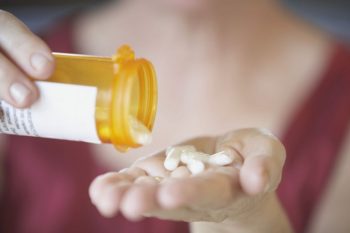Contributing writer for Wake Up World
A little known therapy is gaining ground in treating some of our most devastating disorders and diseases: low-dose naltrexone (LDN). Originally used to help heroin and opiate addicts overcome their addiction, naltrexone works by attaching to the opioid receptors in the brain, which in turn blocks the “high” of the drugs. But it also hinders the body’s own feel-good endorphins and natural opiates. Because people felt so horrible on it, they rarely continued with the therapy.
Naltrexone was poised to fade into pharmaceutical history — that is until Bernard Bihari, MD, discovered that low-doses of the drug had an astounding, life-saving effect on his AIDS patients, as well as those struggling with cancer. He also found LDN was an exceptionally safe, effective and inexpensive treatment for a variety of autoimmune disorders, including: multiple sclerosis, lupus, rheumatoid arthritis, Chrohn’s disease, among others — with zero side-effects.
Normalizing the Immune Response with LDN
[pro_ad_display_adzone id=”110028″]
Dr. Bihari stumbled upon the healing abilities of LDN when he was working with heroin addicts around the time the AIDS epidemic struck. He noticed a correlation between low endorphin levels and high mortality rates in his patients, and suspected that if endorphins could be increased, immunity would be enhanced. Recalling research on how LDN triggered endorphin release, Dr. Bihari decided to give it a try with his AIDS patients. Incredibly, “their endorphin levels doubled or tripled, and more important, their immune systems bounced back and they got better.”
Recognizing the implications of his discovery, he began to delve more deeply into how LDN could help others with compromised immunity. A friend of Dr. Bihari’s was suffering from non-Hodgkin’s lymphoma, with tumors in her neck, chest and abdomen. When he gave her LDN, the tumors rapidly shrank and disappeared. Dr. Bihari also witnessed the seemingly miraculous effect LDN had on multiple sclerosis.
“He also gave LDN to a friend of his daughter who had acute multiple sclerosis (MS), and for five years she had no symptoms. Then she ran out and within a month developed numbness and weakness. She got back on it, and her symptoms resolved. That was 16 years ago, and she has had no MS attacks since.” [source]
Researchers have found that, when taken at bedtime, LDN plugs into opioid receptors, which triggers the body to create large amounts of endorphins and enkephalins. These compounds are powerful immune stimulators. As the LDN quickly wears off, these natural opioids attach to receptors in bone marrow progenitor cells (stem cells), macrophages, natural killer cells, T and B cells, and other immune cells and influence their development, differentiation, and function.
LDN Gives Hope to Cancer Patients
For years, Dr. Bihari has had significant success using LDN to treat patients battling a wide-range of cancers, like colon, prostate, melanoma, multiple myeloma, breast, ovary, uterine, brain, neuroblastoma, lung, Hodgkin’s disease, non-Hodgkin’s lymphoma and chronic lymphocytic leukemia.
Almost 60 percent of his cancer patients who didn’t have success with conventional treatments, experienced benefit from using LDN.
“He followed a group of patients between 1999 and 2004 and reported that 86 had a minimum tumor reduction of 75 percent and were headed toward remission. Another 125 had stabilized but hadn’t achieved that level of tumor shrinkage. Nine had tumor progression, and 84, most of whom were very ill to begin with, died.” [source]
Dr. Burton Berson in Las Cruces, New Mexico has also seen remarkable results using LDN with cancer patients. He published a case study in Integrative Cancer Therapies that documented the incredible recovery of a 46-year-old man who had pancreatic cancer with metastasis to the liver.
Normally, the survival rate of this type of advanced cancer is just three to six months. However, the man began Dr. Berson’s protocol, with 3-4.5 mg of naltrexone at bedtime, as well as 300-600 mg of intravenous alpha lipoic acid (two times a week) and oral lipoic acid, selenium, silymarin and B-complex vitamins. Today, the man is alive and well, back to his normal life without symptoms, and no “appreciable progression of his malignancy.”
Additional Uses
The success of LDN alleviating multiple sclerosis, lupus, rheumatoid arthritis, Crohn’s disease, along with other autoimmune disorders, is also impressive.
According to a study published in the American Journal of Gastroenterology, participants with active Crohn’s disease received 4.5 mg of naltrexone at bedtime for twelve weeks. In all, 89 percent saw improvement of symptoms, and 67 percent went into remission.
Another study conducted by Jarred Younger, PhD, from the Stanford School of Medicine in Pablo Alto, California, found that LDN significantly reduces the pain associated with fibromyalgia.
“We conclude now in 2 separate studies that low-dose naltrexone appears to be efficacious for fibromyalgia,…is easily tolerated, and we know it’s cheap and easy to get hold of. We do need to do larger clinical trials and explore other dosages and medications,” he said.
While side-effects are generally uncommon and mild, naltrexone can cause the following:
- Insomnia and waking early
- Irritability, agitation and restlessness
- Hyperactivity
- Temporary viral activation
Chronic toxicity does not exist, and Naltrexone is considered extremely safe and non-addictive.
Article sources:
- www,whitakerwellness.com/health-concerns/autoimmune-conditions/naltrexone
- www.ldnresearchtrust.org/content/ldn-and-autism
- www.drrachelwest.com/treatments/low-dose-naltrexone-therapy
- www.medscape.com/viewarticle/759253
Recommended articles by Carolanne Wright:
- New Research Links Hand Sanitizer Use With Thyroid Cancer
- Renowned Harvard Psychologist Says ADHD is Largely a Fraud
- Hyperbaric Oxygen Treatment Reverses Fibromyalgia in 70% of Patients, Researchers Find
- Wealth and Social Media Breed Narcissism and Lack of Empathy, Says New Research
- Over 100 Scientific Studies Agree: Cannabis Annihilates Cancer
- If You Care About Animals and the Earth, Here’s Why You Need to Boycott Palm Oil Immediately
- Latest Research on CBD Oil Offers New Hope for Healing Leaky Gut Syndrome and Autoimmune Disorders
- Scientific Breakthrough: Alzheimer’s Ultrasound Therapy Fully Restores Memory Function in Mice
- Why You Should Have a Himalayan Crystal Salt Lamp in Every Room of Your House
[pro_ad_display_adzone id=”110025″]
[pro_ad_display_adzone id=”110027″]







